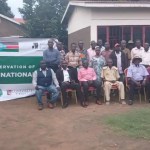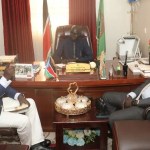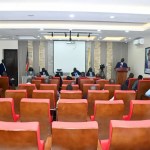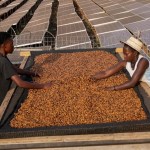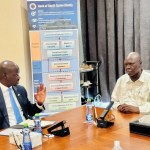(NAIROBI) – Ruto and Museveni Call for Removal of Trade Barriers in East Africa, Highlight Opportunities for South Sudan
Kenyan President William Ruto and Ugandan President Yoweri Museveni have jointly raised concerns about persistent trade restrictions among member states of the East African Community (EAC), warning that such barriers are slowing down regional economic integration and hindering prosperity, including for landlocked countries like South Sudan.
Speaking at a joint press conference at State House Nairobi on Wednesday, the two presidents urged East African nations to take urgent and rational steps to eliminate non tariff barriers and open their markets to one another. Their discussions covered trade, regional peace and security, and cooperation in multiple sectors.
President Ruto noted that trade between member states was still being affected by long-standing non-tariff barriers which continue to frustrate the goals of the EAC. He said that unless countries resolve these issues, the region will not achieve its full economic potential.
President Museveni, in more candid remarks, said that many East African nations have failed to prioritise access to regional markets, calling this a key leadership failure. He noted that Uganda, South Sudan, Rwanda, Burundi, Chad, the Central African Republic, and even Ethiopia, lack direct access to the ocean, making market access through regional integration even more important.
“You have countries like Uganda that have no access to the ocean. South Sudan, Rwanda, Burundi, Chad… and people are not working to solve that. They are content. And you are president, minister…what are you ministering about?” Museveni asked rhetorically.
He likened the region’s fractured trade structure to a house with rooms scattered across different countries, questioning how economic development can happen in such disjointed systems.
Recent tensions have emerged following Tanzania’s move to ban foreigners from 15 economic activities that it classifies as small business ventures. While Tanzania argues this protects its local population from competition, the decision has raised concerns among EAC members, including South Sudan, where citizens frequently face trade restrictions in neighbouring countries. Tanzania also recently reinstated an industrial levy on imports from partner states, which some argue undermines the EAC’s Common External Tariff.
While neither President Ruto nor President Museveni mentioned any specific country, the timing of their statements suggests concern over such protectionist policies. They stressed that internal barriers within the EAC make it difficult for farmers, traders, and businesses to benefit from the regional integration framework.
President Ruto pointed to the East African Community’s potential as a strong regional bloc and said the region must remain focused on unity, economic convergence, and shared prosperity.
Recent statistics from the EAC Secretariat show that trade within the region has been increasing but remains well below potential. In 2024, intra-regional trade grew by 9.35 percent to reach $15.2 billion, which accounted for just 12.17 percent of the region’s total trade volume of $124.9 billion. Analysts believe that this figure could rise to at least 60 percent if member states adhered to joint policies, including the removal of non-tariff barriers and full implementation of the Common External Tariff.
The East African Business Council has estimated that resolving these barriers could unlock up to $63.4 billion in additional trade opportunities across the region. For a country like South Sudan, which is seeking to diversify its economy beyond oil and rebuild its private sector, improved access to regional markets could provide a lifeline for small producers and young entrepreneurs.
President Ruto confirmed that the Joint Monitoring Committee, which oversees bilateral trade matters, will conduct its mid-term review in October. The committee plays a key role in managing trade and cooperation agreements between Kenya and Uganda and could offer a platform for other countries, including South Sudan, to resolve trade disputes.
As part of the visit, Kenya and Uganda signed eight Memoranda of Understanding (MoUs) across various sectors. These include trade, energy, mining, tourism, agriculture, fisheries, investment promotion, and transportation. A separate MoU was signed between the Kenya Bureau of Standards and the Uganda Bureau of Standards to improve cooperation and build technical capacity in standards and quality assurance.
Other agreements involved land and urban development and joint efforts in the Greater Busia Metropolitan Area, which borders both Kenya and Uganda.
Both presidents also stressed the importance of peace and security in the region. They reiterated their shared commitment to regional peacebuilding and inclusive conflict resolution, adding that lasting development in the region requires stable political and security conditions. The leaders pledged closer coordination with regional and international peace efforts.
South Sudan, which relies heavily on trade routes through Kenya and Uganda, is expected to benefit from any improvements in trade integration within the EAC. Regional leaders hope that eliminating non tariff barriers will allow for the smoother flow of goods and services across borders, boosting economies and reducing poverty.
Regional Trade Snapshot (2024 Figures)
| Indicator | Value (USD) | Notes |
|---|---|---|
| Total EAC Trade (Global) | $124.9 billion | Up from $109.4 billion in 2023 |
| Intra-EAC Trade | $15.2 billion | Accounts for 12.17% of total EAC trade |
| Potential Intra-EAC Trade | $63.4 billion | If non-tariff barriers are eliminated |
| South Sudan Exchange Rate (SSP) | SSP 460,000 = $100 | Based on July 2025 official exchange rate |










